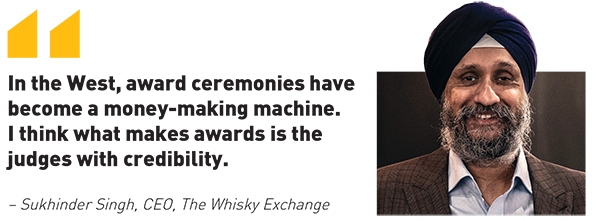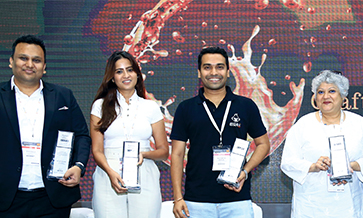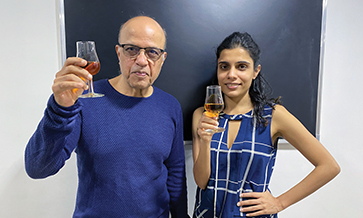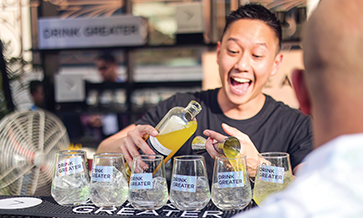Excerpts from the panel discussion on ‘Challenges for modern retail trade’, during Brews&Spirits Expo 2023 in Bengaluru
Moderator: Shreya Soni, Founder & CEO, The Ideas Lab
Panelists:
Sukhinder Singh, CEO, The Whisky Exchange
Smriti Sekhsaria, CMO, Moet Hennessy
Vishal Deorah, CEO, The Whisky Company
Shreya: India’s alcobev industry is one of the biggest in the world, worth an estimated US$50 billion, and we’re showing a healthy 13% growth by 2025, largely driven by whiskey and beer. Do you see any other growth trends or disruptive innovators coming up?
Vishal: If you see the top 10 alcobev companies in the world you’ll see them dominated by beer. So, value-wise, of the top 10 companies you would see eight are beer companies and the remaining spirits companies. That trend is only going to get stronger.
But the market is expanding and because of that new spirits in the growth phase will take up more space in the future. Craft beer companies are experimenting, so they are finding their space. Premium alcohol is also finding space, and so are RTDs and cocktail mixers. Toddy, feni, heritage liquors from Rajasthan, Mahua… these all are finding their space on the shelf.
Shreya: Consumers are assigning a larger part of their disposable income towards drinking and the experiences around it. Are we really noticing the premiumisation of our drinking choices?
Smriti: Premiumisation happens in two ways: you’re consuming the same liquid but buying something better. The second is you’re buying another premium product in a nearby category. The average ticket price of agave-based spirits is probably one of the highest in the category, given the demand-supply ratio. Tequila is a great example where people are premiumising.
You’re also picking occasions when you’re choosing to drink better. When people are drinking at home they’re drinking better whiskies. When they’re drinking in intimate circles, they pull out their bottles of Champagne. This also happens with other spirits and wines.

Shreya: Some countries have created revenue streams by building tourism opportunities with winery tastings, distillery tours, harvest-season celebrations, cocktail festivals, etc. Is there something that the Indian alcobev industry could adopt from these models?
Sukhinder: It’s one of the best forms of marketing, especially distillery tours, because you then understand how the product is made and the passion that goes into it. I know a lot of small distilleries in Scotland that were generating 20% of their profits from tours!
They didn’t need a distributor, they didn’t need a wholesaler, they didn’t need a retailer, they were producers to consumers. So their profit element was very, very high. A new distillery in Taiwan was built around the consumer experience, achieving a million visitors a year. An average distillery in Scotland gets 50,000 visitors a year; a very good Scottish distillery gets 100,000 people visiting.
The Taiwan distilleries brought in children on school trips to the distillery, because they wanted to educate them from a very young age, that alcohol is not just a fun drink, it’s actually a very serious drink that is made with a lot of care and you should drink it with respect.
As well as tours, you’ve got awards and award ceremonies. I think in the West the award ceremonies have become a money-making machine. There are only a handful that I respect, including the IWSC and ISC, because they do it properly.
I think what makes awards is the judges with credibility, they need to have worked in the industry a long time, they need to really understand the trade and they need to be good with liquid of course. If a brand wins an award, it gives the brand a halo effect, which is very powerful. The average consumer wants to know that this product is good.
Shreya: Smriti and her team have often commissioned very consumer-forward and consumer-centric experiences. Do you see some trends emerging in terms of the B2C experiences in the alcobev space?
Smriti: Everybody has been globe-trotting on their devices during the Covid-19 lockdown. Indians are the biggest cohort of Instagram users in the world, apart from Facebook and all of it. They are the biggest followers of American celebrities, Korean celebrities, everything. With that comes digital fatigue and hence the need for in-person experiences.
Post-Covid, we are getting event fatigue. Unlike creating digital content, in-person experiences take a lot of bandwidth, innovation, and creation to meet consumer expectations. Then there are influencer expectations, and industry expectations. You must create programmes and emotions which can have a life of their own.
So, you need to integrate the story of the brand, the product, the experience, what the partner wants and how long this can last, rather than creating single drops. You need to create ecosystems which have their own voice and have longevity to the programmes.
In India, I want to experience something which is once in a lifetime, but not pay too much for it – that’s your Indian consumer! I think there is a lot of expectation, a lot of change, and a great push for the industry to innovate and create.
Sukhinder: I think there seems to be a bit of an attitude. I think events need to be created for different target sets. And they need to be very, very different. I think different cities in India have different attitudes as well.
I strongly believe that events should be paid for. If someone is willing to buy a ticket to come to an event, it means they are serious. If it is invited and it is free, it is just coming to have a few drinks.

Shreya: There is a new, dedicated, focused kind of strategy that is at play in retail stores these days. It’s becoming a lot more experiential, with very tasteful interiors. The entire experience has changed for the consumer. Is that converting into volume growth or sales?
Vishal: I will give you the owner’s and consumer’s perspectives. The common thing everybody has heard is that there is a wider product selection, better consumer experience, knowledgeable staff, brands get a better way to visualise their products.
But if I say that if a 3,000-square-foot store sells X amount, it doesn’t mean that a 30,000-square-foot store will sell 10X. My overheads go high, my returns on my investment are not the same, we also need to stand out in the market. That is a challenge for us, no matter how restrictive or open the environment for retailing is in India. It is still a very competitive space.
That said, large format stores today are an opportunity to be ready for what the industry is going to be 10 years down the line. We believe that if we can open large format stores today and entice the customers to discover more brands and more variety and to expand his/her preferences, then as an industry we can grow.
Shreya: Sukhinder, could I get your global view on that? Where are we going to see massive returns on investments?
Sukhinder: During the Covid-19 restrictions, we ran successful online courses; we conducted virtual whisky, rum and Cognac shows and virtual tasting sessions. When the Covid-era restrictions were lifted, social media became quite unsexy –it’s really boring now. Nothing has moved on.
India is a new market. I think you’ve got to do lots of different things. When I look at retail, I see these new shops, they look beautiful; but I don’t know why I feel like they’re paid-for shops. What I like are stand-alone shops, where the person has done it from the heart. Yes, profit is important, but you need to support the small brands. You need to grow the small brands, and that’s where loyalty comes in.
Shreya: How do we see e-commerce in the alcobev space? Is this a challenge?
Sukhinder: E-commerce is the future. The largest drinks retailers in the world have a very strong e-commerce presence. Even late adopters like Hong Kong and China markets are growing through e-commerce. In India, it’s a challenge. That doesn’t make any sense.
Smriti: Let’s not even go to e-commerce; the first step to that is home delivery. It’s a matter of chain-of-custody and acceptance on the ground. Look at what Swiggy is doing in West Bengal, their statistics for beer home deliveries are mind-boggling. There’s a lot of potential there.
Vishal: India’s states in the North-East are much more industry friendly. In Assam, the online model is an open marketplace. If you award an e-commerce license to one entity, s/he will take over the distribution. In Assam you can go online, place an order, and whichever is the nearest store to your location delivers that order to you. That model is working very nicely for our markets.














